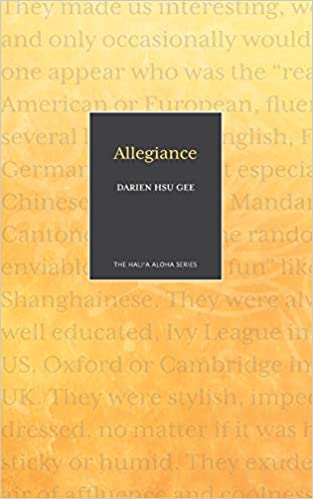
by Michelle Bailat-Jones
“In every frame, another stranger. Again and again, I must start over.”
This is a fitting description of what a flash memoir does: snippets framed and cut from longer moments, a jumble of portals and perspectives woven around connected themes, new wordpaths forged out of remembered glimpses. The line above comes from the second piece in Darien Hsu Gee’s collection Allegiance, a micro memoir called “Lullaby” about, among other things, being sung to in Chinese by her mother when Gee was a young child. Aside from its poetic and emotional truth within the smaller world of “Lullaby”, the line also offers a general hint of the larger work to come. What stands out is this intimation of an artistic practice centered on identity—practice in the sense of work, of a gesture being honed, a repeated attempt to portray the stranger-self.
Allegiance is divided into three roughly linear sections—beginning with Gee’s childhood but moving quickly to young adulthood, marriage, and middle age with its parenting and professional concerns—that together create a gentle and thoughtful chronicle of the very slipperiness of the self. While the early pieces focusing on childhood, like “Mother Tongue” and “Chinese New Year”, and “Biography of a Family by Darien, Age 10”, introduce Gee’s primary touchpoints of geography, language, religion, and inside-the-home culture vs outside-the-home culture, the rest of the collection stretches toward a broader exploration of identity in all its various manifestations. Throughout these short prose flashes, Gee nests a series of echoed questions: Who am I? What kind of frames settle around me? How do others see me? How do I see me? In what personal spaces—memory, relationships, conversations, even physical objects—does identity reside? Where do I belong?
Born in St. Louis to Chinese immigrant parents, most of Gee’s childhood is lived in the United States. Later, the family moves to Hong Kong for four years where Gee and her brother are “…ABCs—American-born Chinese, also known as bananas—white on the inside, yellow on the outside,” as she writes in “Leaving”. She and her brother return to the US to finish high school and attend college, but Gee returns to Asia again as a young adult, to Beijing this time, to work for the China division of an international tax company. All throughout these shifts and movements, the collection emphasizes Gee’s experience of otherness. Chinese to those in her American public school, the only Asian in a Texas Brownie troupe, but also later, when that otherness is flipped during her time in Hong Kong and China.
In “Grave”, a piece about spending a few weeks with part of her family in Taiwan as a teenager, this feeling of otherness is translated through words of longing, and questions of home. She writes of visiting the cemetery with her aunt and not knowing what to do or how to help. She is not used to the heat nor the customs:
I halfheartedly cleared some brush away from the grave, feeling like I should at least try to be a good Chinese granddaughter. It wasn’t much, but it was all I had. When I was finished, I didn’t know where to put the dead branches, so I held them in my hand like an offering and waited for my aunt to finish whatever she was doing.
I wanted air conditioning. I wanted to go home.
But no one was home. There was nowhere else for me to go, no one else who would take me.
There is a real feeling of a spiritual homelessness in Allegiance, already apparent in the childhood sections but heightened through an additional complication in Gee’s life. It is one thing to be a family unit traveling together through a number of international displacements; in an ideal situation, this can create a strong and supportive sense of togetherness. But in Gee’s case, after the family’s expatriate experience in Hong Kong, she and her brother are separated from their parents and from each other to start their boarding school educations. Eventually the parents separate, too. And with adult life come other shifts brought on by parenting, by generational changes. Each additional separation becomes a new rift or crack or fault line, with its own specific edges and layers of displacement. Gee very gently examines these layers, asking other questions about what this all means—about herself, her parents and friends, about trauma and damage, about belonging, and her writerly sensibility has her wondering on the page whether these are even useful words for constructing her own narrative. She makes it clear that words are an integral part of these discussions of otherness and belonging.
One of the delights of the collection is that while these questions gather weight as Gee portrays a lifetime-in-flashes, the craving for answers that a reader might naturally feel is softly and subtly put aside as the narrator ages and with gathered experience eschews easy interpretations.
Toward the end of the collection, a piece named “Artifact” is a clever example of how Gee gestures toward resolution while resisting the lure of pat replies. Honest and emotionally complex, “Artifact” centers on Gee’s relationship with her brother while also presenting academic notions of geology—doubly meaningful because of what we know of their father’s job as a geophysicist.
4.
The study of geology and geophysics is the study of the earth. You use gravitational, magnetic and seismic methods to figure out the earth’s internal structure, its evolution. Rifts, continental sutures, mid-oceanic ridges. Earthquakes. Volcanoes.
5.
My brother and I don’t really know each other. I can say that now, looking back at what we had and what we didn’t. We have some things in common—I hold onto this.
There is also a lovely extra resonance here in the way the content is mirrored in the form: a list of juxtaposed fragments.
Finally, of all the stories, this is one of the most structurally poetic while still maintaining a prose position. It also serves as a small argument against what might be a small criticism of the collection: of the 34 pieces in Allegiance, all but three are micro and flash prose of varying lengths with slight formal variations. The three that vary more significantly, which are structurally poems, are engaging and interesting, but they don’t necessarily earn the slight note of discordance they give in an otherwise uniform prose collection. They do act as little pauses, moments where the reader’s brain must approach Gee’s voice through different rhythms and shapes. Having more like this would have helped, from the very beginning even, giving the larger work a stronger mosaic-like feel. In the end, however, Gee should have the last word, and I’ll happily emphasize what she says in “Artifact”, a position with an elegant emotional truth:
“But fractures have their place—they allow for movement. I can live with that.”
_____________________________
 Michelle Bailat-Jones is a writer and translator. Her novel Fog Island Mountains (Tantor, 2014) won the 2013 Christopher Doheny Award from the Center for Fiction. She has translated the work of C.F. Ramuz (Beauty on Earth, Onesuch Press, 2013; What if the Sun…, 2016) as well as Julia Allard Daudet, Claude Cahun, Laure Mi-Hyun Croset and others. Her short fiction, poetry, translations and criticism have appeared in various journals including The Kenyon Review, Cerise Press, Hayden’s Ferry Review, Two Serious Ladies, Spolia Mag, PANK, The Rumpus and The Quarterly Conversation.
Michelle Bailat-Jones is a writer and translator. Her novel Fog Island Mountains (Tantor, 2014) won the 2013 Christopher Doheny Award from the Center for Fiction. She has translated the work of C.F. Ramuz (Beauty on Earth, Onesuch Press, 2013; What if the Sun…, 2016) as well as Julia Allard Daudet, Claude Cahun, Laure Mi-Hyun Croset and others. Her short fiction, poetry, translations and criticism have appeared in various journals including The Kenyon Review, Cerise Press, Hayden’s Ferry Review, Two Serious Ladies, Spolia Mag, PANK, The Rumpus and The Quarterly Conversation.

 The SmokeLong Grand Micro Contest (The Mikey) is now an annual competition celebrating and compensating the best micro fiction and nonfiction online.
The SmokeLong Grand Micro Contest (The Mikey) is now an annual competition celebrating and compensating the best micro fiction and nonfiction online.